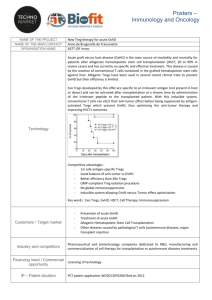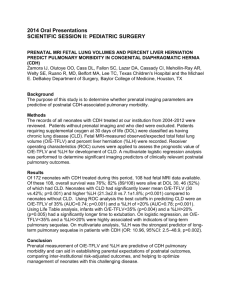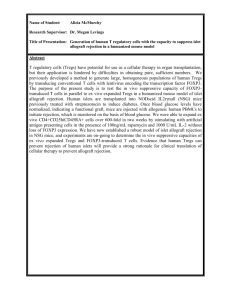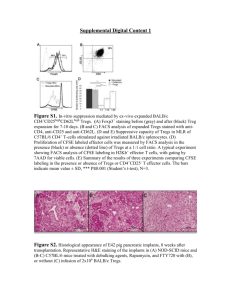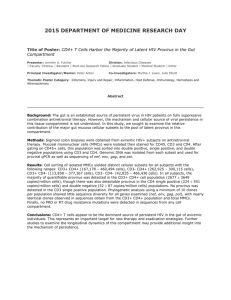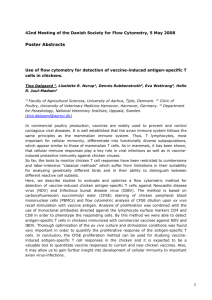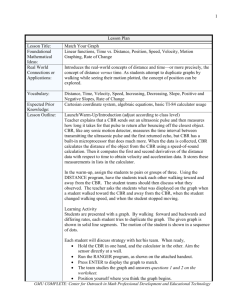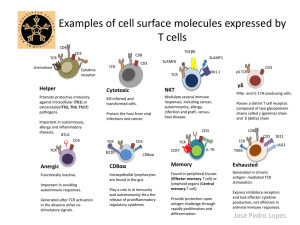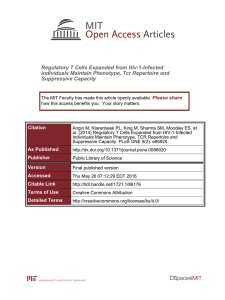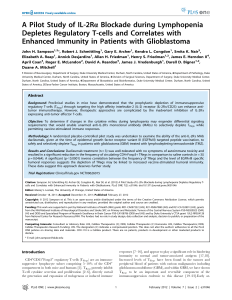Supplementary Information (doc 352K)
advertisement
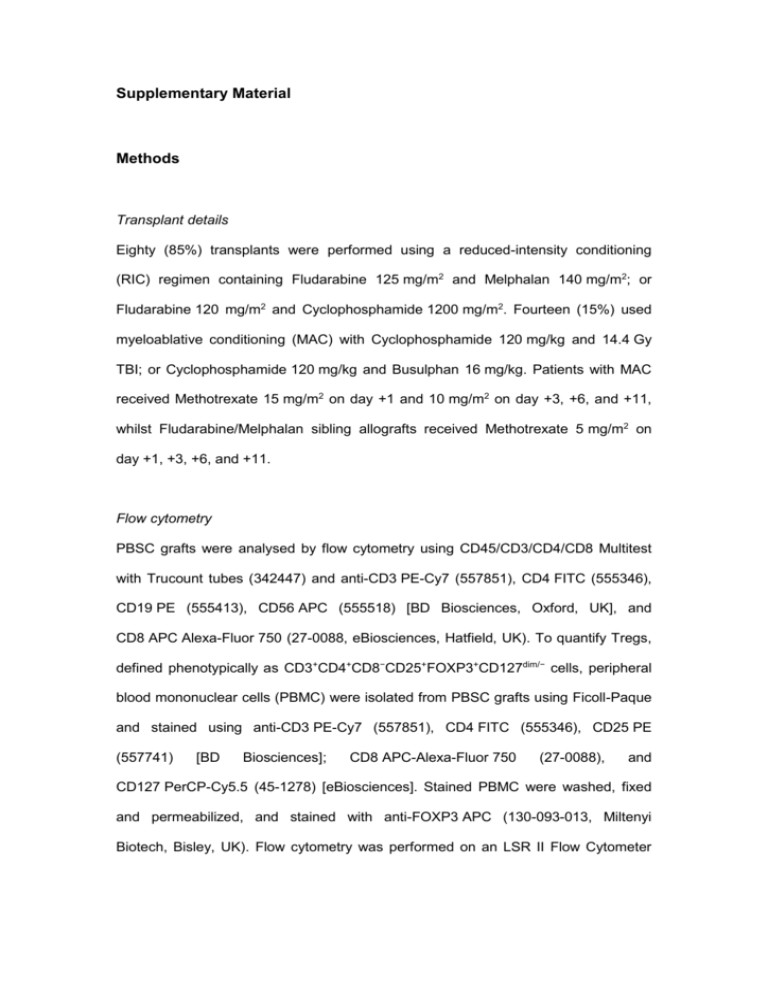
Supplementary Material Methods Transplant details Eighty (85%) transplants were performed using a reduced-intensity conditioning (RIC) regimen containing Fludarabine 125 mg/m2 and Melphalan 140 mg/m2; or Fludarabine 120 mg/m2 and Cyclophosphamide 1200 mg/m2. Fourteen (15%) used myeloablative conditioning (MAC) with Cyclophosphamide 120 mg/kg and 14.4 Gy TBI; or Cyclophosphamide 120 mg/kg and Busulphan 16 mg/kg. Patients with MAC received Methotrexate 15 mg/m2 on day +1 and 10 mg/m2 on day +3, +6, and +11, whilst Fludarabine/Melphalan sibling allografts received Methotrexate 5 mg/m2 on day +1, +3, +6, and +11. Flow cytometry PBSC grafts were analysed by flow cytometry using CD45/CD3/CD4/CD8 Multitest with Trucount tubes (342447) and anti-CD3 PE-Cy7 (557851), CD4 FITC (555346), CD19 PE (555413), CD56 APC (555518) [BD Biosciences, Oxford, UK], and CD8 APC Alexa-Fluor 750 (27-0088, eBiosciences, Hatfield, UK). To quantify Tregs, defined phenotypically as CD3+CD4+CD8−CD25+FOXP3+CD127dim/− cells, peripheral blood mononuclear cells (PBMC) were isolated from PBSC grafts using Ficoll-Paque and stained using anti-CD3 PE-Cy7 (557851), CD4 FITC (555346), CD25 PE (557741) [BD Biosciences]; CD8 APC-Alexa-Fluor 750 (27-0088), and CD127 PerCP-Cy5.5 (45-1278) [eBiosciences]. Stained PBMC were washed, fixed and permeabilized, and stained with anti-FOXP3 APC (130-093-013, Miltenyi Biotech, Bisley, UK). Flow cytometry was performed on an LSR II Flow Cytometer using FACS Diva software (BD Biosciences). Staining controls were fluorescenceminus-one, isotype controls, and antigen negative cells. Statistics Sample size was calculated with overall survival as the primary outcome. The historical 3-year overall survival for allogeneic HSCT for Oxford University Hospitals NHS Trust is 60-65%. Based upon these data, this study was designed to detect a difference of 25%, with an estimated 3-year overall survival of 50% and 75% in the low and high Treg/CD4+ T-cell groups, respectively. With a one-sided model using an α value of 0.05 and β value of 0.2, the estimated sample size was 45 in each arm. Variables initially considered in univariate analysis were recipient and donor age; sex mismatch (female donor to male recipient vs other); ABO mismatch (matched/minor vs major/bidirectional); recipient and donor CMV serology; disease (acute leukaemia vs other); disease stage (Early (CR1/chronic phase/untreated) vs Other (≥ CR2/partial response/active disease); conditioning (RIC vs MAC); donor (sibling vs unrelated). Graft variables considered were CD34+, CD3+, CD19+, CD3−CD56+, Treg (CD3+CD4+CD25+FOXP3+CD127dim/−) dose, and the Treg/CD4+ T-cell ratio. Table S1. Analysis of the PBSC graft contents. A. Cell type Treg/CD4+ T-cell ratio Treg dose r P r P TNC 0.45 < 0.0001 0.03 0.78 CD34+ 0.13 0.22 0.02 0.86 CD3+ 0.65 < 0.0001 −0.10 0.35 CD19+ 0.53 < 0.0001 0.12 0.25 CD3−CD56+ 0.50 < 0.0001 0.12 0.25 B. Univariate Variable Treg Counts (108) Donor Harvest Treg/CD4+ T cells Donor Gender Median Range P Sibling 4.35 1.73-13.78 0.01 Unrelated 3.48 0.48-10.54 One day 3.51 0.48-9.62 Two days 6.76 2.36-13.87 Sibling 0.033 0.011-0.086 Unrelated 0.026 0.008-0.061 Male 0.030 0.008-0.086 Female 0.028 0.014-0.045 β < 0.001 R2 0.24 0.24 Variable B SE B Treg Counts (108)* Constant 0.84 0.72 Harvest 3.02 0.56 Constant −1.44 0.04 Donor −0.10 0.04 −0.28 0.01 Gender −0.10 0.04 −0.24 0.03 Treg/CD4+ T cells# 0.07 P C. Multivariate 0.49 0.04 < 0.001 0.09 (A) Spearman correlation (r) between Treg dose ( 106/kg) or proportion of Tregs (Tregs/CD4+ T cells), and the dose ( 106/kg) of the main cell populations in the graft. (B) Univariate analysis of the Treg counts ( 108) and proportion of Tregs (Tregs/CD4+ T cells) in the graft. Analysed by Mann-Whitney test. (B) Multivariate linear regression of Treg counts ( 108) and proportion of Tregs (Tregs/CD4+ T cells)) in the graft. *Data were transformed using a √ transformation; # Data were transformed using a log10 [x/(1−x)] transformation; Tregs, regulatory T cells. Table S2. Timing and cause of mortality. Low Treg/CD4+ T-cell ratio High Treg/CD4+ T-cell ratio Day Cause Day Cause 10 Infection 18 Venoocclusive disease 16 Infection 20 Infection 35 GvHD 25 Infection 43 GvHD 59 Pneumonitis 44 Relapse 146 Relapse 74 GvHD 157 Relapse 116 Relapse 171 Relapse 143 Relapse 199 Relapse 145 Thrombosis 241 GvHD 161 Infection 304 Relapse 163 GvHD 339 PTLD 198 Relapse 427 Relapse 221 Relapse 1484 Relapse 226 GvHD 240 Neuropathy 245 GvHD 252 Infection 256 GvHD 258 Relapse 315 GvHD 317 GvHD 566 Relapse 747 Intracranial haemorrhage 845 Relapse Tregs, regulatory T cells; PTLD, post-transplant lymphoproliferative disorder. Table S3. Overall survival according to the proportion of Tregs (Tregs/CD4+ T cells) in the PBSC grafts (quartiles). A. Univariate analysis Group Tregs/CD4+ T cells 3-year OS (%) 95% CI 1st quartile 0.0081-0.0222 42 26-67 2nd quartile 0.0223-0.0295 57 40-81 3rd quartile 0.0296-0.0393 67 50-89 4th quartile 0.0394-0.0856 83 69-100 B. Multivariate analysis Variable HR + Tregs/CD4 T cells Recipient CMV 95% CI P 1st quartile 1.00 2nd quartile 0.74 0.30-1.82 0.51 3rd quartile 0.63 0.25-1.56 0.32 4th quartile 0.22 0.06-0.73 0.01 Seronegative 1.00 Seropositive 2.23 1.07-4.66 0.03 (A) Kaplan-Meier estimation of 3-year overall survival according to the proportion of Tregs (Tregs/CD4+ T cells) in the grafts, divided by quartiles. (B) Multivariate analysis of overall survival. Variables included in the initial model were the Treg/CD4+ T-cell ratios in the peripheral blood stem cell grafts (quartiles) adjusting for significant differences between the groups (donor age, donor gender, and CD3−CD56+ cell dose) and variables with P < 0.10 in univariate analysis (recipient age, recipient CMV serology, and HLA-mismatch in HvG direction). Tregs, regulatory T cells; OS, overall survival. B. Alemtuzumab (n=58) 1.0 1.0 A. No Alemtuzumab (n=36) Low %Tregs High %Tregs 0.6 0.2 0.4 Probability 0.6 0.4 0.2 Probability 0.8 0.8 Low %Tregs High %Tregs P = 0.07 0.0 0.0 P = 0.20 0 1 2 3 Time (Years) 4 5 0 1 2 3 4 5 Time (Years) Figure S1. Overall survival in T-replete and T-deplete transplants according to the proportion of Tregs (Tregs/CD4+ T cells) in the graft. (A) No Alemtuzumab conditioning; (B) Alemtuzumab conditioning. Low %Tregs, Tregs/CD4+ T cells below the median (dotted line); High %Tregs, Tregs/CD4+ T cells above the median (solid line); Tregs, regulatory T cells.
